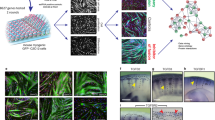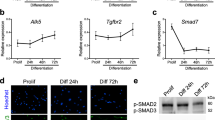Abstract
Wnt7a signals through its receptor Fzd7 to activate the planar-cell-polarity pathway and drive the symmetric expansion of satellite stem cells resulting in enhanced repair of skeletal muscle. In differentiated myofibres, we observed that Wnt7a binding to Fzd7 directly activates the Akt/mTOR growth pathway, thereby inducing myofibre hypertrophy. Notably, the Fzd7 receptor complex was associated with Gαs and PI(3)K and these components were required for Wnt7a to activate the Akt/mTOR growth pathway in myotubes. Wnt7a–Fzd7 activation of this pathway was completely independent of IGF-receptor activation. Together, these experiments demonstrate that Wnt7a–Fzd7 activates distinct pathways at different developmental stages during myogenic lineage progression, and identify a non-canonical anabolic signalling pathway for Wnt7a and its receptor Fzd7 in skeletal muscle.
This is a preview of subscription content, access via your institution
Access options
Subscribe to this journal
Receive 12 print issues and online access
$209.00 per year
only $17.42 per issue
Buy this article
- Purchase on SpringerLink
- Instant access to full article PDF
Prices may be subject to local taxes which are calculated during checkout





Similar content being viewed by others
References
Gordon, M. D. & Nusse, R. Wnt signalling: multiple pathways, multiple receptors, and multiple transcription factors. J. Biol. Chem. 281, 22429–22433 (2006).
Wodarz, A. & Nusse, R. Mechanisms of Wnt signalling in development. Annu. Rev. Cell Dev. Biol. 14, 59–88 (1998).
Montcouquiol, M. & Kelley, M. W. Planar and vertical signals control cellular differentiation and patterning in the mammalian cochlea. J. Neurosci. 23, 9469–9478 (2003).
Le Grand, F., Jones, A. E., Seale, V., Scime, A. & Rudnicki, M. A. Wnt7a activates the planar cell polarity pathway to drive the symmetric expansion of satellite stem cells. Cell Stem Cell 4, 535–547 (2009).
Tajbakhsh, S. et al. Differential activation of Myf5 and MyoD by different Wnts in explants of mouse paraxial mesoderm and the later activation of myogenesis in the absence of Myf5. Development 125, 4155–4162 (1998).
Chen, A. E., Ginty, D. D. & Fan, C. M. Protein kinase A signalling via CREB controls myogenesis induced by Wnt proteins. Nature 433, 317–322 (2005).
Borello, U. et al. The Wnt/β-catenin pathway regulates Gli-mediated Myf5 expression during somitogenesis. Development 133, 3723–3732 (2006).
Anakwe, K. et al. Wnt signalling regulates myogenic differentiation in the developing avian wing. Development 130, 3503–3514 (2003).
Rochat, A. et al. Insulin and wnt1 pathways cooperate to induce reserve cell activation in differentiation and myotube hypertrophy. Mol. Biol. cell 15, 4544–4555 (2004).
van der Velden, J. L. et al. Inhibition of glycogen synthase kinase-3β activity is sufficient to stimulate myogenic differentiation. Am. J. Physiol. 290, C453–C462 (2006).
Brack, A. S., Conboy, I. M., Conboy, M. J., Shen, J. & Rando, T. A. A temporal switch from notch to Wnt signalling in muscle stem cells is necessary for normal adult myogenesis. Cell Stem Cell 2, 50–59 (2008).
Kuang, S., Kuroda, K., Le Grand, F. & Rudnicki, M. A. Asymmetric self-renewal and commitment of satellite stem cells in muscle. Cell 129, 999–1010 (2007).
Glass, D. J. Skeletal muscle hypertrophy and atrophy signalling pathways. Int. J. Biochem. Cell Biol. 37, 1974–1984 (2005).
Crescenzi, M., Crouch, D. H. & Tato, F. Transformation by myc prevents fusion but not biochemical differentiation of C2C12 myoblasts: mechanisms of phenotypic correction in mixed culture with normal cells. J. Cell Biol. 125, 1137–1145 (1994).
Collins, A. R., Squires, S. & Johnson, R. T. Inhibitors of repair DNA synthesis. Nucleic Acids Res. 10, 1203–1213 (1982).
Tanaka, S., Akiyoshi, T., Mori, M., Wands, J. R. & Sugimachi, K. A novel frizzled gene identified in human esophageal carcinoma mediates APC/β-catenin signals. Proc. Natl Acad. Sci. USA 95, 10164–10169 (1998).
Kengaku, M. et al. Distinct WNT pathways regulating AER formation and dorsoventral polarity in the chick limb bud. Science 280, 1274–1277 (1998).
Harwood, A.J. Regulation of GSK-3: a cellular multiprocessor. Cell 105, 821–824 (2001).
Parrizas, M., Gazit, A., Levitzki, A., Wertheimer, E. & LeRoith, D. Specific inhibition of insulin-like growth factor-1 and insulin receptor tyrosine kinase activity and biological function by tyrphostins. Endocrinology 138, 1427–1433 (1997).
Kandarian, S. C. & Jackman, R. W. Intracellular signalling during skeletal muscle atrophy. Muscle Nerve 33, 155–165 (2006).
Miyazaki, M. & Esser, K. A. Cellular mechanisms regulating protein synthesis and skeletal muscle hypertrophy in animals. J. Appl. Physiol. 106, 1367–1373 (2009).
Pietrangelo, T. et al. Characterization of specific GTP binding sites in C2C12 mouse skeletal muscle cells. J. Muscle Res. Cell Motil. 23, 107–118 (2002).
Freissmuth, M. et al. Suramin analogues as subtype-selective G protein inhibitors. Mol. Pharmacol. 49, 602–611 (1996).
Schulte, G. & Bryja, V. The Frizzled family of unconventional G-protein-coupled receptors. Trends Pharmacol. Sci. 28, 518–525 (2007).
Foord, S. M. et al. International Union of Pharmacology. XLVI. G protein-coupled receptor list. Pharmacol. Rev. 57, 279–288 (2005).
Timmers, S., Schrauwen, P. & de Vogel, J. Muscular diacylglycerol metabolism and insulin resistance. Physiol. Behav. 94, 242–251 (2008).
Frost, R. A. & Lang, C. H. Protein kinase B/Akt: a nexus of growth factor and cytokine signalling in determining muscle mass. J. Appl. Physiol. 103, 378–387 (2007).
Tisdale, M. J. Cancer cachexia. Curr. Opin. Gastroenterol. 26, 146–151 (2010).
Sakuma, K. & Yamaguchi, A. Molecular mechanisms in aging and current strategies to counteract sarcopenia. Curr. Aging Sci. 3, 90–101 (2010).
Costelli, P. et al. IGF-1 is downregulated in experimental cancer cachexia. Am. J. Physiol. Regul. Integr. Comp. Physiol. 291, R674–R683 (2006).
Botfield, C., Ross, R. J. & Hinds, C. J. The role of IGFs in catabolism. Baillieres Clin. Endocrinol. Metab. 11, 679–697 (1997).
Lang, C. H., Hong-Brown, L. & Frost, R. A. Cytokine inhibition of JAK-STAT signalling: a new mechanism of growth hormone resistance. Pediatr. Nephrol. 20, 306–312 (2005).
Grounds, M. D., Radley, H. G., Gebski, B. L., Bogoyevitch, M. A. & Shavlakadze, T. Implications of cross-talk between tumour necrosis factor and insulin-like growth factor-1 signalling in skeletal muscle. Clin. Exp. Pharmacol. Physiol. 35, 846–851 (2008).
Del Aguila, L. F. et al. Muscle damage impairs insulin stimulation of IRS-1, PI 3-kinase, and Akt-kinase in human skeletal muscle. Am. J. Physiol. Endocrinol. Metab. 279, E206–E212 (2000).
de Alvaro, C., Teruel, T., Hernandez, R. & Lorenzo, M. Tumor necrosis factor alpha produces insulin resistance in skeletal muscle by activation of inhibitor κB kinase in a p38 MAPK-dependent manner. J. Biol. Chem. 279, 17070–17078 (2004).
Megeney, L. A., Kablar, B., Garrett, K., Anderson, J. E. & Rudnicki, M. A. MyoD is required for myogenic stem cell function in adult skeletal muscle. Genes Dev. 10, 1173–1183 (1996).
von Maltzahn, J., Euwens, C., Willecke, K. & Sohl, G. The novel mouse connexin39 gene is expressed in developing striated muscle fibers. J. Cell Sci. 117, 5381–5392 (2004).
Parker, M. H., Perry, R. L., Fauteux, M. C., Berkes, C. A. & Rudnicki, M. A. MyoD synergizes with the E-protein HEB beta to induce myogenic differentiation. Mol. Cell. Biol. 26, 5771–5783 (2006).
Gillespie, M. A. et al. p38-{γ}-dependent gene silencing restricts entry into the myogenic differentiation program. J. Cell Biol. 187, 991–1005 (2009).
McKinnell, I. W. et al. Pax7 activates myogenic genes by recruitment of a histone methyltransferase complex. Nat. Cell Biol. 10, 77–84 (2008).
Acknowledgements
The authors thank F. Price and V. Soleimani for critical reading of the manuscript. M.A.R. holds the Canada Research Chair in Molecular Genetics and is an International Research Scholar of the Howard Hughes Medical Institute. C.F.B. is supported by the Swiss National Science Foundation. This work was financially supported by grants from the Muscular Dystrophy Association, Canadian Institutes of Health Research, National Institutes of Health, Howard Hughes Medical Institute and the Canada Research Chair Program.
Author information
Authors and Affiliations
Contributions
J.v.M. and M.A.R. planned the experimental design, analysed data and wrote the paper. J.v.M. and C.F.B. conducted the experiments.
Corresponding author
Ethics declarations
Competing interests
M.A.R. is a founding scientist and consultant with Fate Therapeutics.
Supplementary information
Supplementary Information
Supplementary Information (PDF 1334 kb)
Supplementary Table 1
Supplementary Information (XLS 22 kb)
Supplementary Table 2
Supplementary Information (XLS 21 kb)
Supplementary Table 3
Supplementary Information (XLS 20 kb)
Rights and permissions
About this article
Cite this article
von Maltzahn, J., Bentzinger, C. & Rudnicki, M. Wnt7a–Fzd7 signalling directly activates the Akt/mTOR anabolic growth pathway in skeletal muscle. Nat Cell Biol 14, 186–191 (2012). https://doi.org/10.1038/ncb2404
Received:
Accepted:
Published:
Issue Date:
DOI: https://doi.org/10.1038/ncb2404
This article is cited by
-
WNT7A promotes tumorigenesis of head and neck squamous cell carcinoma via activating FZD7/JAK1/STAT3 signaling
International Journal of Oral Science (2024)
-
Intrafusal-fiber LRP4 for muscle spindle formation and maintenance in adult and aged animals
Nature Communications (2023)
-
Exosomal Wnt7a from a low metastatic subclone promotes lung metastasis of a highly metastatic subclone in the murine 4t1 breast cancer
Breast Cancer Research (2022)
-
Cryo-EM structure of constitutively active human Frizzled 7 in complex with heterotrimeric Gs
Cell Research (2021)
-
A Cdh1–FoxM1–Apc axis controls muscle development and regeneration
Cell Death & Disease (2020)



